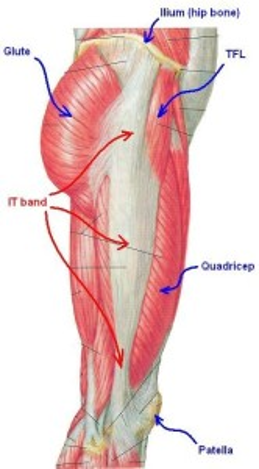Chances are if you’ve done almost any type of exercise in the last few years you will have heard of, seen or used a foam roller. Many of you may also have been instructed to roll your Iliotibial Band (ITB) to “loosen it” or “stretch it out”. And I’m sure if you’ve tried this in the past you’re ITB will be hurting just thinking about it. But, “No Pain No Gain” right? … Wrong!
Foam rolling has been a great addition to many athletes’ recovery strategies in the past few years. A reduction in muscle tension, improvement in short term flexibility, improved blood flow, an increase in body awareness and aiding in injury prevention and rehabilitation have all been reported benefits of using a foam roller. One of the most common options for foam rolling is the ITB to alleviate knee pain. However, there is a lot of debate in the physio community weather it’s effective or a waste of time.
Firstly, what is the ITB? It’s a dense, fibrous band of connective tissue that runs from the hip to the lower leg connecting to numerous muscles and contributes to stability of the knee and hip. The lateral part of the knee is the common site of pain due to its movement over the attachment point below the knee.
It often feels tight, like it needs to be stretched. However this tight feeling may be because it’s being overstretched.. You’re physio will be able to determine if you have a cross over gait pattern while you run or workout causing you to overload the ITB.
It’s tight, I should foam roll it, right? The ITB is not a muscle. It does not have any contractile tissues that are found in muscles. Muscle fibres respond very well to releasing and reducing tone with foam rolling. Rolling muscles will feel sore at first but should gradually get easier after a minute or so. The ITB, however, has been shown to be a high tensile structure not too dissimilar to a steel cable. So will rolling on some foam loosen that structure? I don’t think so. However, foam rolling the muscles surrounding it can be a great alternative.
Therefore, we are in the “don’t roll” corner for a couple of reasons:
- Foam rolling is unlikely to increase it’s length like a muscle will so any pain relief is most likely to be temporary from inhibition of neural tissue rather than changing anything mechanical.
- Even if foam rolling did help to release or lengthen the ITB, this isn’t going to help runners control the movement at the hip and knee, which could then make us worse in the long term!
- Over doing the foam rolling to this area can increase the irritation to the knee and make your pain worse
So what should I do instead?
- Foam roll tight muscles around the hip and knee such as your glutes, quads and hip flexors. Your physio will show how to best roll these without irritating the ITB
- Work on strengthening the muscles that control the hip and knee to prevent to ITB to be overloaded in the first place!

